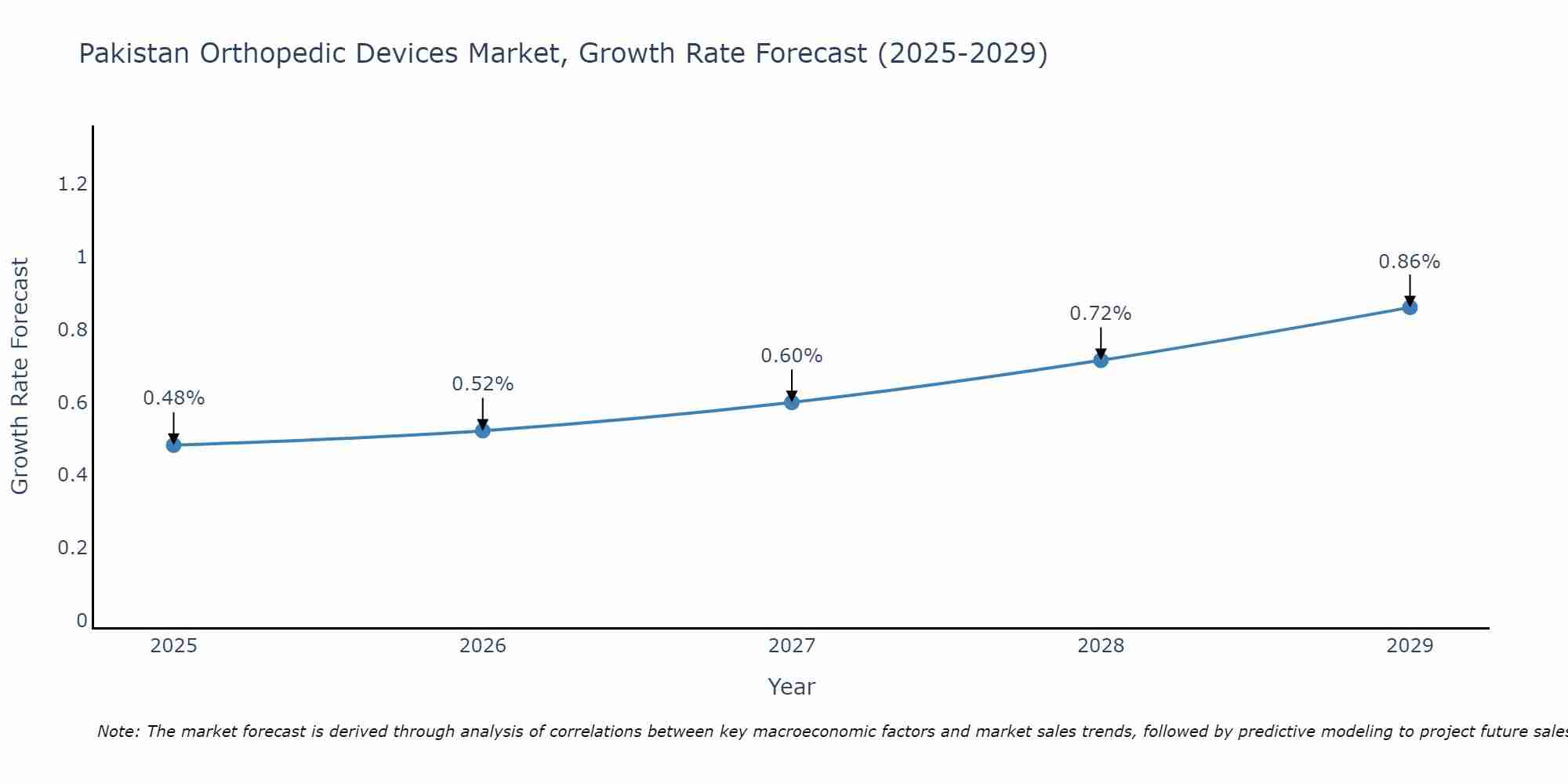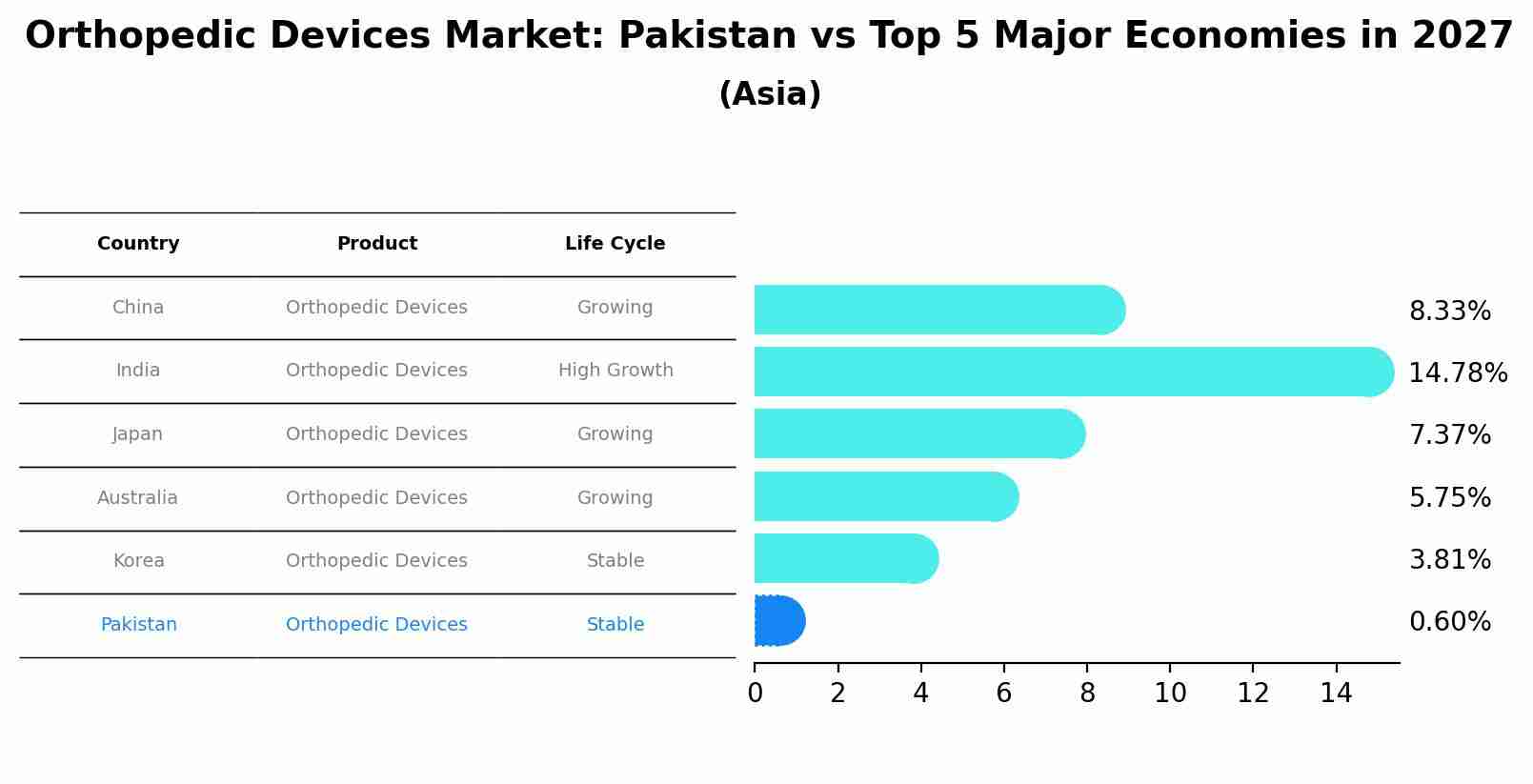Pakistan Orthopedic Devices Market Outlook | Forecast, Trends, Analysis, Revenue, Size, COVID-19 IMPACT, Value, Growth, Industry, Companies & Share
| Product Code: ETC368137 | Publication Date: Aug 2022 | Updated Date: Jul 2025 | Product Type: Market Research Report | |
| Publisher: 6Wresearch | Author: Dhaval Chaurasia | No. of Pages: 75 | No. of Figures: 35 | No. of Tables: 20 |
Pakistan Orthopedic Devices Market Size Growth Rate
The Pakistan Orthopedic Devices Market is likely to experience consistent growth rate gains over the period 2025 to 2029. From 0.48% in 2025, the growth rate steadily ascends to 0.86% in 2029.

Orthopedic Devices Market: Pakistan vs Top 5 Major Economies in 2027 (Asia)
In the Asia region, the Orthopedic Devices market in Pakistan is projected to expand at a stable growth rate of 0.60% by 2027. The largest economy is China, followed by India, Japan, Australia and South Korea.

Pakistan Orthopedic Devices Market Synopsis
The Pakistan Orthopedic Devices Market is experiencing steady growth driven by factors such as an aging population, increasing incidence of orthopedic disorders, and a rise in sports-related injuries. The market encompasses a wide range of products including joint reconstruction devices, spinal devices, trauma fixation devices, orthobiologics, and orthopedic accessories. Key players in the market are investing in research and development to introduce innovative products, while partnerships and collaborations are enhancing market competitiveness. Government initiatives to improve healthcare infrastructure and rising awareness about advanced orthopedic treatments are further propelling market growth. However, challenges such as limited access to advanced healthcare facilities in rural areas and high costs of orthopedic procedures are hindering market expansion. Overall, the Pakistan Orthopedic Devices Market presents opportunities for growth and innovation in the coming years.
Pakistan Orthopedic Devices Market Trends
The Pakistan Orthopedic Devices Market is witnessing several key trends, including a growing demand for minimally invasive surgical procedures, an increasing prevalence of orthopedic disorders due to the aging population, and advancements in technology leading to the development of innovative implant materials and designs. Additionally, there is a rising trend towards personalized orthopedic solutions tailored to individual patient needs, as well as a focus on improving post-operative care and rehabilitation services. The market is also seeing a rise in the adoption of robotic-assisted surgical techniques for improved precision and outcomes. Overall, these trends are shaping the orthopedic devices market in Pakistan towards more efficient, patient-centric, and technologically advanced solutions.
Pakistan Orthopedic Devices Market Challenges
The Pakistan Orthopedic Devices Market faces several challenges, including limited healthcare infrastructure in rural areas, inadequate access to advanced orthopedic treatments and devices, high cost of orthopedic implants leading to affordability issues for patients, and a lack of skilled orthopedic professionals in certain regions. Additionally, regulatory hurdles and import restrictions on medical devices can hinder market growth and innovation. The market also grapples with counterfeit products, which pose risks to patient safety and impact the credibility of genuine orthopedic device manufacturers. Addressing these challenges will require collaborative efforts from the government, healthcare providers, industry stakeholders, and regulatory bodies to improve access to quality orthopedic care and promote the use of advanced orthopedic devices in Pakistan.
Pakistan Orthopedic Devices Market Investment Opportunities
The Pakistan Orthopedic Devices Market presents promising investment opportunities due to the country`s growing healthcare sector and increasing prevalence of orthopedic conditions. With a rising aging population and higher incidence of lifestyle-related musculoskeletal disorders, there is a growing demand for orthopedic devices such as implants, prosthetics, and orthotic equipment. Investors can explore opportunities in manufacturing and distributing innovative orthopedic products that cater to the specific needs of the Pakistani market. Additionally, partnerships with local healthcare providers and institutions can help in expanding market presence and enhancing distribution networks. Overall, the Pakistan Orthopedic Devices Market offers potential for growth and investment returns driven by the increasing healthcare awareness and improving healthcare infrastructure in the country.
Jordan Agar Market Government Policies
The Pakistan government has implemented various policies to regulate and promote the orthopedic devices market in the country. These policies include the registration and licensing requirements for orthopedic devices manufacturers and suppliers to ensure product quality and safety. Additionally, the government has established guidelines for pricing and reimbursement of orthopedic devices to make them more accessible to the population. There are also regulations in place to govern the import and distribution of orthopedic devices to prevent counterfeit products from entering the market. Furthermore, the government encourages local production of orthopedic devices through incentives and support programs to reduce dependency on imports and boost the domestic industry. Overall, these policies aim to ensure the availability of high-quality orthopedic devices in Pakistan and promote the growth of the market.
Pakistan Orthopedic Devices Market Future Outlook
The Pakistan Orthopedic Devices Market is expected to show steady growth in the coming years due to factors such as the rising prevalence of orthopedic conditions, an aging population, and increasing awareness about advanced treatment options. Technological advancements in orthopedic devices, such as robotics-assisted surgeries and 3D printing, are also likely to drive market growth. Additionally, the government`s focus on improving healthcare infrastructure and increasing healthcare expenditure will further propel the market forward. However, challenges such as the high cost of orthopedic devices and limited access to specialized healthcare services in rural areas may hinder market growth to some extent. Overall, the Pakistan Orthopedic Devices Market is poised for expansion with opportunities for innovation and market penetration in the forecast period.
Key Highlights of the Report:
- Pakistan Orthopedic Devices Market Outlook
- Market Size of Pakistan Orthopedic Devices Market, 2021
- Forecast of Pakistan Orthopedic Devices Market, 2031
- Historical Data and Forecast of Pakistan Orthopedic Devices Revenues & Volume for the Period 2018 - 2031
- Pakistan Orthopedic Devices Market Trend Evolution
- Pakistan Orthopedic Devices Market Drivers and Challenges
- Pakistan Orthopedic Devices Price Trends
- Pakistan Orthopedic Devices Porter's Five Forces
- Pakistan Orthopedic Devices Industry Life Cycle
- Historical Data and Forecast of Pakistan Orthopedic Devices Market Revenues & Volume By Application for the Period 2018 - 2031
- Historical Data and Forecast of Pakistan Orthopedic Devices Market Revenues & Volume By Hip Orthopedic Devices for the Period 2018 - 2031
- Historical Data and Forecast of Pakistan Orthopedic Devices Market Revenues & Volume By Knee Orthopedic Devices for the Period 2018 - 2031
- Historical Data and Forecast of Pakistan Orthopedic Devices Market Revenues & Volume By Spine Orthopedic Devices for the Period 2018 - 2031
- Historical Data and Forecast of Pakistan Orthopedic Devices Market Revenues & Volume By Craniomaxillofacial Orthopedic Devices for the Period 2018 - 2031
- Historical Data and Forecast of Pakistan Orthopedic Devices Market Revenues & Volume By Dental Orthopedic Devices for the Period 2018 - 2031
- Historical Data and Forecast of Pakistan Orthopedic Devices Market Revenues & Volume By Sports Injuries, Extremities And Trauma (Set) Orthopedic Devices for the Period 2018 - 2031
- Historical Data and Forecast of Pakistan Orthopedic Devices Market Revenues & Volume By Product for the Period 2018 - 2031
- Historical Data and Forecast of Pakistan Orthopedic Devices Market Revenues & Volume By Drill Guide for the Period 2018 - 2031
- Historical Data and Forecast of Pakistan Orthopedic Devices Market Revenues & Volume By Guide Tubes for the Period 2018 - 2031
- Historical Data and Forecast of Pakistan Orthopedic Devices Market Revenues & Volume By Implant Holder for the Period 2018 - 2031
- Historical Data and Forecast of Pakistan Orthopedic Devices Market Revenues & Volume By Custom Clamps for the Period 2018 - 2031
- Historical Data and Forecast of Pakistan Orthopedic Devices Market Revenues & Volume By Distracters for the Period 2018 - 2031
- Historical Data and Forecast of Pakistan Orthopedic Devices Market Revenues & Volume By Screw Drivers for the Period 2018 - 2031
- Historical Data and Forecast of Pakistan Orthopedic Devices Market Revenues & Volume By Accessories for the Period 2018 - 2031
- Pakistan Orthopedic Devices Import Export Trade Statistics
- Market Opportunity Assessment By Application
- Market Opportunity Assessment By Product
- Pakistan Orthopedic Devices Top Companies Market Share
- Pakistan Orthopedic Devices Competitive Benchmarking By Technical and Operational Parameters
- Pakistan Orthopedic Devices Company Profiles
- Pakistan Orthopedic Devices Key Strategic Recommendations
Frequently Asked Questions About the Market Study (FAQs):
- Single User License$ 1,995
- Department License$ 2,400
- Site License$ 3,120
- Global License$ 3,795
Search
Related Reports
- Vietnam System Integrator Market (2025-2031) | Size, Companies, Analysis, Industry, Value, Forecast, Growth, Trends, Revenue & Share
- ASEAN and Thailand Brain Health Supplements Market (2025-2031) | Strategy, Consumer Insights, Analysis, Investment Trends, Opportunities, Growth, Size, Share, Industry, Revenue, Segments, Value, Segmentation, Supply, Forecast, Restraints, Outlook, Competition, Drivers, Trends, Demand, Pricing Analysis, Competitive, Strategic Insights, Companies, Challenges
- ASEAN Bearings Market (2025-2031) | Strategy, Consumer Insights, Analysis, Investment Trends, Opportunities, Growth, Size, Share, Industry, Revenue, Segments, Value, Segmentation, Supply, Forecast, Restraints, Outlook, Competition, Drivers, Trends, Demand, Pricing Analysis, Competitive, Strategic Insights, Companies, Challenges
- Europe Flooring Market (2025-2031) | Outlook, Share, Industry, Trends, Forecast, Companies, Revenue, Size, Analysis, Growth & Value
- Saudi Arabia Manlift Market (2025-2031) | Outlook, Size, Growth, Trends, Companies, Industry, Revenue, Value, Share, Forecast & Analysis
- Uganda Excavator, Crane, and Wheel Loaders Market (2025-2031) | Strategy, Consumer Insights, Analysis, Investment Trends, Opportunities, Growth, Size, Share, Industry, Revenue, Segments, Value, Segmentation, Supply, Forecast, Restraints, Outlook, Competition, Drivers, Trends, Demand, Pricing Analysis, Competitive, Strategic Insights, Companies, Challenges
- Rwanda Excavator, Crane, and Wheel Loaders Market (2025-2031) | Strategy, Consumer Insights, Analysis, Investment Trends, Opportunities, Growth, Size, Share, Industry, Revenue, Segments, Value, Segmentation, Supply, Forecast, Restraints, Outlook, Competition, Drivers, Trends, Demand, Pricing Analysis, Competitive, Strategic Insights, Companies, Challenges
- Kenya Excavator, Crane, and Wheel Loaders Market (2025-2031) | Strategy, Consumer Insights, Analysis, Investment Trends, Opportunities, Growth, Size, Share, Industry, Revenue, Segments, Value, Segmentation, Supply, Forecast, Restraints, Outlook, Competition, Drivers, Trends, Demand, Pricing Analysis, Competitive, Strategic Insights, Companies, Challenges
- Angola Excavator, Crane, and Wheel Loaders Market (2025-2031) | Strategy, Consumer Insights, Analysis, Investment Trends, Opportunities, Growth, Size, Share, Industry, Revenue, Segments, Value, Segmentation, Supply, Forecast, Restraints, Outlook, Competition, Drivers, Trends, Demand, Pricing Analysis, Competitive, Strategic Insights, Companies, Challenges
- Israel Intelligent Transport System Market (2025-2031) | Strategy, Consumer Insights, Analysis, Investment Trends, Opportunities, Growth, Size, Share, Industry, Revenue, Segments, Value, Segmentation, Supply, Forecast, Restraints, Outlook, Competition, Drivers, Trends, Demand, Pricing Analysis, Competitive, Strategic Insights, Companies, Challenges
Industry Events and Analyst Meet
Our Clients
Whitepaper
- Middle East & Africa Commercial Security Market Click here to view more.
- Middle East & Africa Fire Safety Systems & Equipment Market Click here to view more.
- GCC Drone Market Click here to view more.
- Middle East Lighting Fixture Market Click here to view more.
- GCC Physical & Perimeter Security Market Click here to view more.
6WResearch In News
- Doha a strategic location for EV manufacturing hub: IPA Qatar
- Demand for luxury TVs surging in the GCC, says Samsung
- Empowering Growth: The Thriving Journey of Bangladesh’s Cable Industry
- Demand for luxury TVs surging in the GCC, says Samsung
- Video call with a traditional healer? Once unthinkable, it’s now common in South Africa
- Intelligent Buildings To Smooth GCC’s Path To Net Zero













